“Tourism is not possible everywhere. Longsheng can do it first because of its excellent tourism resources.” On the way to Longsheng Longji Terraced Field Scenic Spot, Yang Guodong, director of the Industry Promotion Section of Guilin Tourism Development Committee, said so.
Longsheng Autonomous County of All Nationalities, located in Guilin City, Guangxi Zhuang Autonomous Region, has a forest coverage rate of nearly 80% . It is difficult to see greenery in Longsheng at a glance. In 2014, the Chinese Academy of Sciences tested the air, soil and water quality in Longsheng. The data showed that the average content of negative oxygen ions in the air in Longsheng was 4,980 per cubic meter, and some areas reached more than 20,000; among the eight water quality monitoring points, four It can be used as high-quality mineral water, and the others have reached the national first-class drinking water source standard; the soil is selenium-rich soil. There are no chemical enterprises in Longsheng County.
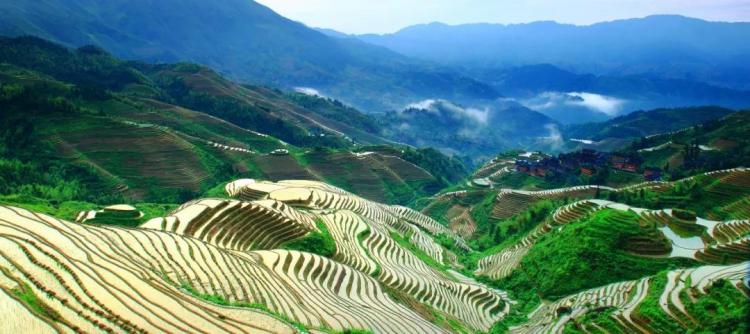
▲Landscape of Longji Rice Terraces▲
The Longji Terraced Fields in Longsheng County are high and low, continuous and rich in color, which can be called magnificent. It is a concentrated expression of the wisdom and strong will of farmers in ancient my country, and it is also an agricultural wonder that still has a breath of life. The title of “one of the most beautiful terraced fields in China” is by no means too high.
The reason why I pay attention to Longsheng is that the Guilin Rural Tourism Poverty Alleviation Project in Longsheng County, jointly carried out by Guilin Tourism Development Committee and Airbnb, chose Jinjiang Village in Longji Scenic Area to renovate two residential buildings and carry out pilot homestays.
From the original intention of the homestay pilot, we learned a number of tourism development experiences gained from the practice and exploration of a village, a scenic spot and even a county. For Longsheng, one of the major tourism counties in the Greater Guilin tourism circle, the poverty alleviation effect of tourism can be said to be the result of the healthy development of the scenic spot, and the concept of global tourism provides a basis for Longsheng to spread the driving effect of tourism to the whole county. an appropriate opportunity.
The non-core area finds its own starting point
The Longji Terraced Fields Scenic Area includes ten administrative villages, among which Ping’an Village, Dazhai Village, Longji Village and Xiaozhai Village are located in the core scenic area. The Jiangbian Group of Jinjiang Village, where the pilot homestay is located, is not in the core scenic spot, and guests pass by the gate, which brings very limited tourism benefits to this natural village.
Huangluo Yao Village, which also belongs to Jinjiang Village, has found a unique development path.
Huangluo is located under the Ping’an Village in the core scenic spot. Before the road was built up to the mountain, the villagers of Huangluo obtained sporadic tourism income by helping tourists lead the way and carry backpacks. Later, a photographer came to Huangluo and found that the long hair and clothing of the local women were very distinctive. They paid a few yuan to ask Huangluo women to go to the riverside to comb their hair and take pictures.
Yao women’s long hair is generally not displayed to the public, but Huangluo villagers gradually discovered their business experience in it. At the beginning, in the main room of a folk house, a dozen or so sisters-in-law sang some simple folk songs, danced one or two self-made dances, and invited a bowl of camellia oleifera, which was regarded as entertaining guests.
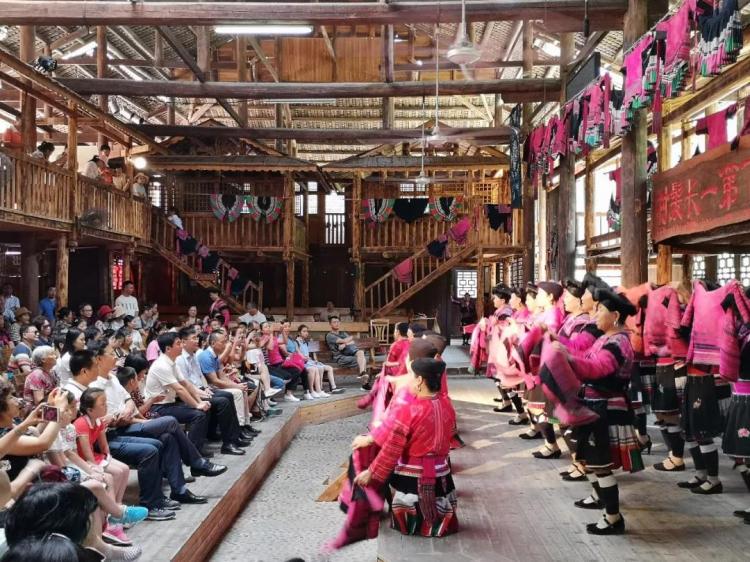
▲Huangluo Yaozhai women performing long hair dance▲
At this stage, Huangluo’s long-haired dance performance was completely voluntary by the villagers, until the county tourism bureau realized its potential and arranged for teachers from the county cultural center to sort out and dig out the culture of the Huangluo villagers, raising the level of the show to a higher level . In 2015, teachers who knew Longsheng were invited to improve the music, dance, and performance forms again, forming the version that is now staged every day.
The performance venue was changed from the main house of the villagers at the beginning to a performance venue funded by the county government, and then to a wooden building with local characteristics. During the period, Huang Luo declared the Guinness Book of World Records for “the most long hair in a group”, officially playing the title of “the first village with long hair in the world”.
Now Huang Luo’s long hair dance performance is completely different from the song and dance in the main room. “However, its content and form still seem relatively friendly, and it will not make people feel fake. Every link and every performance is closely related to their lives and customs, and they all exist originally. “ Mao Yiren, director of Longsheng Tourism Bureau, commented.
There are more and more women participating in the performance, and the performance team has grown from a few people to two or three groups to perform in turn. This program is completely starred by villagers, and women in the whole village can participate regardless of their appearance, age and body shape. When there are many audiences, ten performances can be performed every day. Actors can get salary according to the number of performances, in addition to salary and dividends. In 2017, the performance dividends in Huangluo Village reached more than 2 million.
After the performance became more and more successful, Huangluo Yaozhai began to develop industries. Local women wash their hair with boiled rice water fermented in earthen pots, which has a good hair care effect. After the title of “The First Long Hair Village in the World” was launched, the traditional shampoo formula was improved and became a local specialty – Hongyao shampoo, and formed multiple brands.
As the Longji Terraced Fields are awarded the Global Important Agricultural Cultural Heritage and included in the key cultivation list of national 5A-level scenic spots in the whole region, more and more tourists will come to Longji. In the core area, 80% of the villagers have run farmhouses, and it is still difficult to avoid the overload of tourists. The phenomenon of short supply and shoddy goods has begun to emerge . At the same time, the differences in the needs of different tourists are becoming more and more obvious. “Many tourists (traveling out) like to be quiet now. After the inns in the core area are too dense, they are very complicated and the layout is chaotic.”
The County Tourism Bureau hopes to divert tourists from the core area and let the scenic spot drive more tourism in surrounding villages. This requires that the villages in the non-core area also have points that can attract tourists.
Huang Luo found his unique starting point. “There are other natural villages in Jinjiang Village, like this village (referring to the Jiangbian Group), we need to find a starting point.” As the Jiangbian Group introduced Airbnb’s tourism poverty alleviation project and created a demonstration site for boutique homestays, Airbnb started from homestays. The concept, home decoration, catering production, management and operation, publicity and sales, etc. are trained for the villagers, and the project is handed over to the company established by the village collective for operation, and the village collective manages and distributes dividends. According to the project design, not only the villagers who rent out the idle houses will receive rental income, but the village collective will also receive income, so that the income of the project will cover the entire natural village.
With the help of Airbnb’s influence and tourist source market, let the homestay demonstration sites play an effective demonstration and driving role , which will bring a reference development model and more diversification to the rural tourism around Longji Scenic Area and even other towns in Longsheng development space.
Terraced Field Scenic Area Benefits More Villagers
Whether it is Jinjiang Village, which introduced the Airbnb tourism poverty alleviation project, or Huangluo, which took the long hair dance performance as a breakthrough, their development opportunities come from the Longji Rice Terraces.
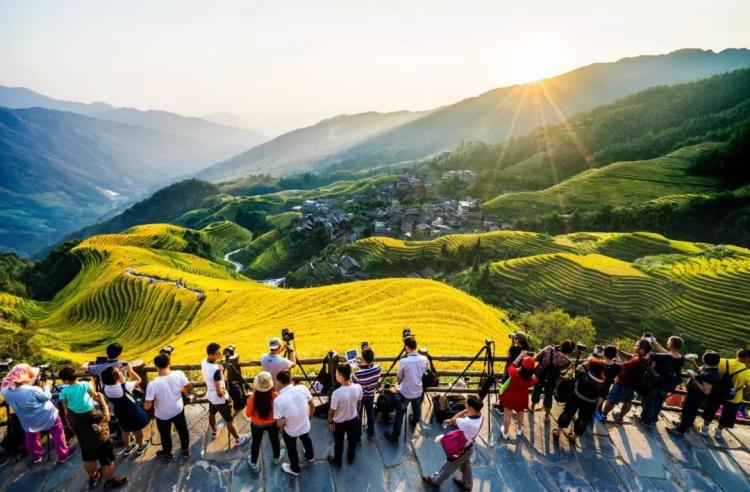
▲The viewing platform in the core area is crowded with tourists▲
“Many scenic spots close the outside door, and the inside is a pure sightseeing scenic spot. The Longji Terraces still have their uniqueness.” Mao Yiren thought for a while and said, “We can say that this is a community-type scenic spot.”
As the core landscape, terraced fields cannot exist without farmers. Without people farming, there is no terraced landscape. For the Longji Terraced Fields, the development of the scenic spot will benefit the local villagers at the same time. Rather than saying that the scenic spot drives the local villagers, it is better to say that the scenic spot and the villagers have a win-win cooperation.
It is very difficult to grow terraced fields. In many places, rice is no longer grown, and crops with high economic value such as mangosteen and passion fruit have begun to be planted. However, as the terraced fields of the landscape, the core scenic spot still needs someone to plant rice. This requires the local people to have visible benefits from the terraced field scenic spot and get direct income through planting terraced fields.
Longji Tourism Company has formulated a distribution plan for this purpose: take a certain percentage of ticket revenue as terrace maintenance fees and dividend income. The terrace maintenance fee is 1,000 yuan per mu, and as long as the villagers plant the terraces, they can get it. The dividend income is 7% of the total ticket income. Each village has someone to count the number of tourists received, and distribute among the villages according to the number of tourists received by each village.
In this way, the terraced fields that the villagers who run inns and restaurants have no time to manage are also cultivated, and the villagers who are unable to directly manage them can earn income by planting their own and other villagers’ terraced fields. Dividends are calculated based on the turnover of ticket sales, because the price of tickets and the number of tourists are the most clear and intuitive to villagers, and unnecessary suspicion in the process of calculating dividends is avoided from the design of the system.
The income of villagers is divided into two parts: terrace maintenance fee and ticket income dividend, which balances the interests of villages in core scenic spots and non-core scenic spots to a certain extent. The villages in the core area receive far more tourists than the villages in the non-core area, which means much higher ticket income dividends. Taking Dazhai as an example, the ticket dividend income has increased year by year from more than 300,000 yuan per year, reaching more than 5.3 million yuan in 2017. The terrace maintenance fee enables villagers to secure a certain income through farming regardless of the location of their houses or fields.
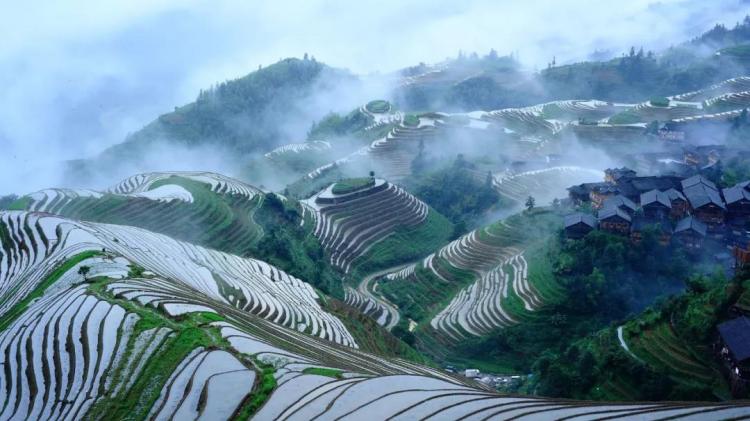
▲Landscape of Longji Rice Terraces▲
Longji Tourism Company has introduced a large number of tourists to the scenic spot, and the villagers have received real benefits through operating inns, restaurants and other tourist reception projects. But Mao Yiren said frankly that some negative things have also been produced as a result. When the villagers realized that as long as they built an inn, they would not have to worry about having no guests. Problems such as building indiscriminately and building higher and higher were exposed. “Originally, the houses here were all three-story, but now there is no limit to the height of the floors. I can’t wait to build more than ten floors.”
In the Ping’an Village in the core area, Mao Yiren pointed to several exquisite small buildings closest to the viewing platform and told us: These are all illegal buildings, and according to the regulations, it is not allowed to build houses here.
The phenomenon of illegal construction in scenic spots has been repeatedly banned, which is related to the fact that villagers have not yet formed the awareness of jointly protecting the style of the village, and is also related to the incomplete match between relevant regulations and actual conditions. Developing tourism and carrying out tourism-related businesses are the objective needs of local villagers to improve their income and living standards. At the same time, the ecological beauty of traditional buildings and the overall style and image of scenic spots must also be protected.
In order to strike a balance between the two, the Longsheng County Party Committee and the county government are taking different measures to deal with illegal buildings according to different situations: to renovate the overall appearance of the houses that have obtained legal procedures; to resolutely demolish the illegal buildings that are under construction plan; for the illegal buildings that have been built, they will be demolished or rectified in accordance with relevant legal procedures.
In the long run, the more important thing is to strengthen the publicity and education of the villagers, and form a consensus among all the villagers to protect the core resources of the scenic spot and create a world-class landscape.
Covering the entire county to break traffic restrictions
Behind the “chaos” of illegal buildings, it also shows that the tourism industry has a significant role in driving the local economy. However, tourists are still mainly concentrated in the core scenic spot of Longji Terraces, and the spontaneous tourism operation mode of villagers is still relatively simple.

▲Landscape of Longji Rice Terraces▲
Blocking water is better than dredging water. From the perspective of the overall situation, the task before the County Tourism Bureau is to explore more diverse tourism development models, revitalize the tourism resources of the whole county, and divert tourists from the Longji Terraced Fields Scenic Area to other areas of Longsheng.
Introducing Airbnb, building demonstration sites of homestays and forming a driving force is just one of the paths. However, the Longji terraced fields account for less than one-tenth of the county’s area, and the overall ecological environment of Longsheng County is excellent, which is suitable for the development of rural leisure and vacation.
The Longji Rice Terraces are “a fairyland on earth sprinkled in the sky”. Tourists from all over the world know Longsheng because of the Longji Rice Terraces. When tourists come to Longsheng, how to make them get a better travel experience, let them stay and live in Longsheng for 2-3 days?
Traffic is the biggest bottleneck in the development of Longsheng tourism. Having said that, Mao Yiren even stretched out a hand to gesture. “We are all valleys here. Assuming this is a county seat, every time tourists go to a town, they go and come back. There is a high valley blocking it. So they go to the bottom of the river, come back, go to Weijiang, come back, go Equality, back again, that’s it. The roads are small and hard to repair. Traffic limits our development.”

▲Travel Map of Longsheng Autonomous County of All Nationalities▲
In order to open up the roads between towns and towns, the Longsheng County Party Committee and the county government are planning to build a large ring road for poverty alleviation through eco-tourism. After the ring line is built, tourists can go from one town to another town along the ring line, or return to the county seat, with more freedom of choice. In this way, tourists in Longji Scenic Area can be effectively diverted. In order to make the ring road more attractive, the County Tourism Bureau plans Yao, Miao, Dong, and Zhuang characteristic towns in Sishui, Weijiang, Pingping, and Piaoli respectively, and fully taps the characteristics of the sub-regional settlements of various ethnic minorities in Longsheng Autonomous County. .
The Longji Terraced Fields are located in the south of Longsheng County, and the Nanshan Mountains in the north are another large-scale tourism resource. The County Tourism Bureau plans to build two points, Longji and Nanshan, one south and one north, with characteristic towns connected in the middle, plus many points like Jinjiang Village that can develop rural tourism. The turntable is turning.” At present, the local government is uniting forces from all walks of life to actively explore feasible solutions that can effectively solve the demand for construction funds.
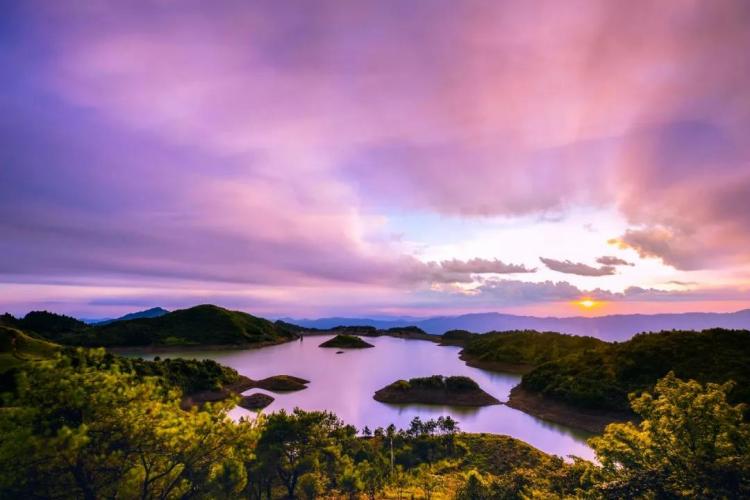
▲Nanshan▲
“Ecology” is one of the key words in Longsheng’s development plan. Longsheng is a key ecological functional area, and there is no room for vigorous industrial development. Excellent ecology is the precious resource of Longsheng. Since 2015, Longsheng has completely prohibited sand mining in rivers, broad-leaved forest logging, and the approval of small hydropower projects. Various measures have been taken to protect Longsheng’s ecological environment.
Across the country, areas with excellent natural resource endowments like Longsheng are not uncommon. There is a high degree of overlap between poverty and good ecological resources in space, which is also one of the realistic foundations for the vigorous promotion of “tourism poverty alleviation”. Making good use of resources, positioning well, and doing tourism development that is truly beneficial to the long-term local development will be eternal issues and challenges for regions with high-quality tourism resources.
Yang Guodong noticed some problems in tourism development in other southwestern mountainous areas. “Many (projects) are piled up with government funds. Some natural landscapes are acceptable, but many services cannot keep up… After it is built, there will be no tourists. What’s the use?”
When overlooking the terraced fields, Mao Yiren pointed to the ridges and said with emotion that sometimes the roads in scenic spots are too neatly built, which is meaningless. There are people living in it like this, and there are some traces of life, so it is more flavorful.
notes
Rich and diverse minority cultures are undoubtedly an important advantage for tourism development.
Li Xinjian, Dean of the School of Tourism Management of Beijing International Studies University, believes that many elements in ethnic minority areas are worth exploring and deeply integrating with tourism. “For the eastern region, more elements are added from the outside. For example, the Moganshan homestay is not something that exists in the local area, but is cut in from the outside. What new things should be developed by the villages in the eastern region? Come, it may be difficult. But the ethnic minority areas are different, there are indeed many things that can attract us, and many things that can go deep into the ‘+’.”
However, the “degree” of ethnic cultural tourism development is often difficult to grasp. Appropriate tourism development, display and dissemination of national culture is a good thing for local people to increase income and improve cultural self-confidence. On the other hand, tourism development is also a double-edged sword. According to Lu Huilin, professor of sociology at Peking University, tourism development needs to be vigilant that folk customs are completely stripped from the original life of villagers and become an exhibit under the eyes of curiosity, causing damage to the original culture and way of life.
When mentioning this point, Lu Huilin took the Wa hair-swinging dance as an example: If one day we perform hair-swinging like the Wa people in ethnic villages, this ceremony is actually completely divorced from the local life and production system.
Contrary to the example of the Wa hair throwing dance, the long hair dance of the Huangluo Yao nationality was originally intended to be a performance, but it has gradually become an activity that the whole village participates in, and an important part of the villagers’ livelihood and life. “There are almost no people in this village who go out to work, and those who marry in follow the custom here to participate in the performance.”
In the view of Yang Guodong, who has seen many ethnic performances, Huangluo Changfa Dance is “the most localized in China.” Things can be sublimated, not go astray, and not make people feel awkward. This is easy to say, but it is really rare to be able to do it.
A story that has little to do with tourism may have something to do with it. For the 50th anniversary of Longsheng Autonomous County of All Ethnic Groups, an attempt was made. All large-scale events and theatrical program directors, creators, actors, and hosts used people from Longsheng or working in Longsheng, thus cultivating There are a lot of local talents who can do performance direction, screenwriting, creation and overall planning. “After doing such activities several times, the whole county has been mobilized. Everyone gradually understands what can be excavated, how big the ‘big’ can be, and how small the ‘small’ can be.”
This is 2001. It has also taken nearly 30 years for Huangluo Changfa Dance to develop from a spontaneous song and dance performance to the current performance version.
Longsheng has both rare large-scale terraced fields and rich and diverse minority cultures, and has unique resources in tourism development. With an accurate grasp of its own resources and positioning, Longsheng has proved with its steady tourism development that sometimes “slowly” is “fast” when it comes to the “right” rhythm and direction.




